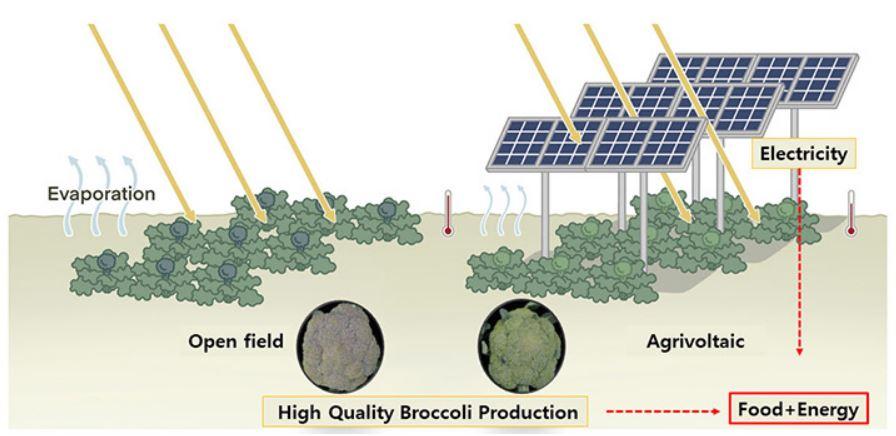Agrivoltaics: The Next Era of Agricultural?
Agrivoltaics, also known as Agricultural Photovoltaics (APV), is based on the principle of combining photosynthesis and the photovoltaic effect.

Photosynthesis comes from biology, and the photovoltaic effect comes from physics. Based on these two principles, agricultural photovoltaics has been derived. In practical application, it can not only increase the light energy utilization efficiency of farmland and improve the yield and quality of crops but also utilize the remaining space of farmland for power generation, realizing the multi-functional utilization of land resources.
The Symbiotic Benefits of Agrivoltaics
As solar energy is being vigorously promoted, solar photovoltaic panels are gradually bringing many benefits beyond just power generation.
Agrivoltaics benefits:
Promoting agricultural technology development
The upgrades and transformations of agricultural infrastructure driven by agrivoltaics projects often help improve the automation and mechanization level of agricultural facilities, which can help increase crop yields, especially in areas with excessive sunlight and high temperatures.
Improving power generation efficiency
Studies have shown that the surface temperature of solar panels installed above vegetation is much lower than that of panels installed on bare ground. This cooling effect directly affects the power generation efficiency of solar photovoltaic panels, because under normal conditions above 25 degrees Celsius (77 degrees Fahrenheit), the power generation efficiency of solar photovoltaic panels will decrease by 0.1% to 0.5% for every 1 degree Celsius increase.
Increasing economic income
Farmers can obtain rental income by leasing their land to solar photovoltaic power generation companies, or benefit by renting the land of solar power companies at a lower cost to grow crops, which helps to reduce the risks brought by fluctuations in crop yields and market prices. These leasing agreements can provide farmers with stable, predictable land income and also reduce the economic burden of farmers investing in solar power generation facilities on their own.
In addition to the economic benefits, agrivoltaics also contribute to additional benefits:
Easing the tight power supply
By developing distributed renewable energy generation, it reduces the dependence on centralized power grids.
Driving diversified regional development
The development and maintenance of agrivoltaics systems can also create job opportunities in rural areas, promoting the sustainable development of the local economy and society.
Future Development Trends of Agrivoltaics
Agrivoltaics has broad development prospects and will play an increasingly important role in improving agricultural production efficiency, clean energy supply, and industry chain improvement in the future
Scaled development and continuous cost reduction
With the increase in policy support and technological progress, the scale of agrivoltaics projects will continue to expand. Meanwhile, the costs of core components such as photovoltaic modules, batteries, and inverters will continue to decline, driving down the overall investment cost and improving the economic viability of agrivoltaics.
Expanding application scenarios
Agrivoltaics can not only be implemented on traditional farmland, but can also be extended to orchards, pastures, and livestock farms. It can also be combined with smart agriculture, agricultural product processing, and other industries to form more diverse application scenarios.
Significant improvement in agricultural production efficiency
Agrivoltaics can provide a shaded environment, reducing the impact of direct sunlight on crops, and can also cultivate some shade-tolerant crops. This can not only increase the yield per unit area but also increase farmers' income.
Enhanced capacity for clean energy supply
Large-scale agrivoltaics projects will become an important source of distributed clean energy supply, providing renewable electricity for rural areas and promoting rural energy transformation.
Gradual improvement of the industrial chain
With the development of agrivoltaics, related equipment manufacturing, system integration, operation and maintenance services, and other industrial chains will become more complete, forming a comprehensive industrial ecosystem.
Improved digital management capabilities
In the future, agrivoltaics projects will widely apply technologies such as the Internet of Things, big data, and artificial intelligence to achieve intelligent monitoring and centralized remote control, improving operation and maintenance efficiency.
Summary
The emergence of agrivoltaics provides a new approach for humans to solve the problem of energy scarcity. At the same time, it faces many challenges, such as the complex policy framework and lack of comprehensive land use strategic planning.
Reasonable planning and coordination of the relationship between agricultural production and photovoltaic power generation, avoiding the large-scale occupation of farmland resources. Comprehensively considering the technical requirements and management needs of photovoltaic power generation and crop cultivation, popularize professional planning, design, and operation management. The government needs to introduce clearer policy support, provide more subsidies and incentives for agrivoltaics projects, reduce investment thresholds, and promote the implementation and development of projects. I believe that agrivoltaics will receive further development and promotion in the future.